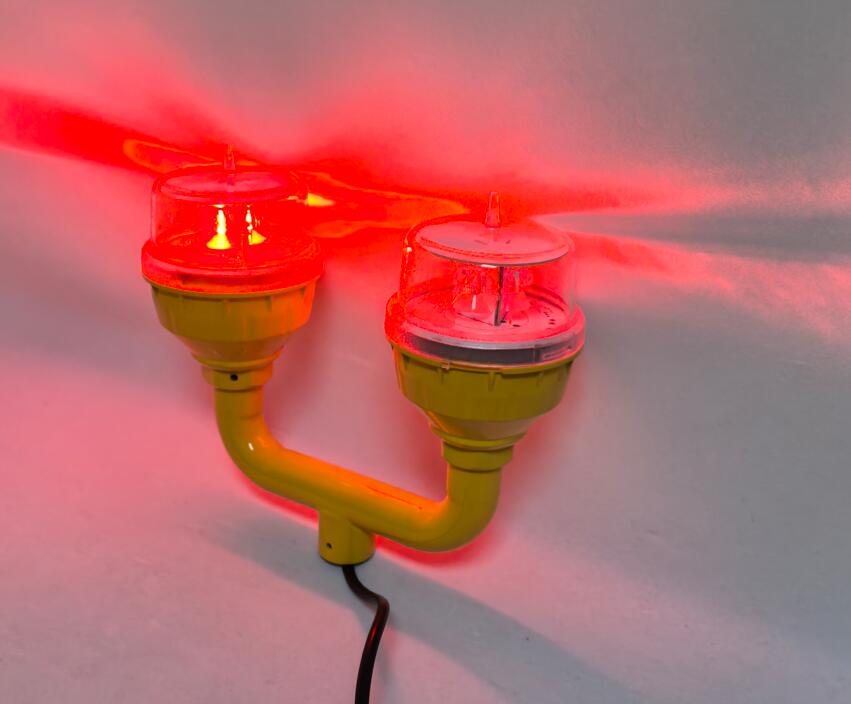In the intricate dance of modern aviation, safety is the non-negotiable rhythm that guides every flight. As our infrastructure reaches ever skyward with wind turbines, communication masts, and skyscrapers, the imperative to mark these obstacles effectively becomes paramount. Enter the dual obstruction light, a sophisticated evolution in safety technology that has become the gold standard for critical installations. This system moves beyond single-point failure risks, introducing a layer of redundancy that ensures the skyways remain safe, 24 hours a day, 365 days a year.
Unlike conventional single-lamp units, the core principle of a dual obstruction light is built-in redundancy. It incorporates two independent, fully functional light sources within a single, robust housing. This design is not merely a convenience; it is a fundamental engineering response to a critical need. Should the primary lamp fail, the secondary unit activates automatically and seamlessly, without any interruption in the warning signal. This fail-safe mechanism is crucial for structures where maintenance access is difficult, dangerous, or weather-dependent, such as offshore wind farms or remote telecommunication towers. The dual obstruction light effectively guarantees continuous compliance with stringent aviation regulations, providing peace of mind to asset owners and pilots alike.
The Technological Heart: Beyond Simple Redundancy
The superiority of the modern dual obstruction light lies not just in its dual lamps but in the intelligent system that governs them. Early redundant systems were often bulky and inefficient. Today, advancements in LED technology and integrated control systems have revolutionized their design.

High-flux LEDs are the engine of this revolution. They offer exceptional brightness while consuming minimal energy, and their incredible lifespan—often exceeding 100,000 hours—drastically reduces the need for activation of the backup lamp. Furthermore, sophisticated photocells and control circuitry are the brains of the operation. These systems automatically manage the switch between day, night, and twilight intensity settings and continuously monitor the health of each lamp. The housing itself is a feat of engineering, typically constructed from die-cast aluminum to provide superior heat dissipation, corrosion resistance, and protection against the elements, from extreme UV exposure to salt spray and heavy rain.
| dual obstruction light |
Revon Lighting: The Vanguard of Dual Obstruction Light Innovation
In the global market for aviation obstruction lighting, few names command as much respect for innovation and quality as Revon Lighting. As a leading manufacturer from China, Revon Lighting has carved its niche by specializing in high-reliability solutions, with their range of dual obstruction light products standing as a testament to their engineering prowess. They understand that in aviation safety, reliability is not just a feature—it is the entire product.
| dual obstruction lights |
The quality of a Revon Lighting dual obstruction light is evident from the moment of inspection. Each unit is built to exacting standards, utilizing premium materials that ensure longevity in the harshest environments. Their proprietary thermal management system prevents LED degradation, guaranteeing consistent light output over time. The seamless transition between primary and secondary lamps is instantaneous, a critical feature that underscores their commitment to zero-downtime performance. By rigorously testing every component and subjecting entire units to accelerated life-cycle testing, Revon Lighting ensures that their products do not just meet international standards but exceed them. This unwavering dedication to quality makes Revon Lighting the supplier of choice for engineers and project managers who cannot afford to compromise on safety.
Application and Impact: Where Dual Lights are Non-Negotiable
The application of dual obstruction light systems is particularly critical in specific sectors. Offshore wind energy projects, for instance, rely on these lights to mark turbines miles out at sea, where maintenance crews face logistical challenges and harsh conditions. Similarly, tall structures in densely populated areas or near airports require the utmost reliability to prevent catastrophic incidents. The use of a dual obstruction light in these contexts is a clear statement of priority for asset protection and public safety. It represents a proactive investment in risk mitigation, ensuring that a single point of failure never leads to a regulatory violation or, worse, a safety hazard.
The Unblinking Sentinel of the Skies
As our world continues to build upward and outward, the demand for fail-safe safety systems will only intensify. The dual obstruction light stands as a pinnacle of this evolution, offering a robust solution that embodies the principle of redundancy. It is the unblinking sentinel that never sleeps, ensuring that the pathways of the air remain clear and secure. With industry pioneers like Revon Lighting continuously pushing the boundaries of performance and durability, the future of aviation safety is not just brighter—it is smarter, more reliable, and fundamentally more resilient. The persistent, assured glow of a dual obstruction light is a silent promise of safety, upheld by cutting-edge engineering.